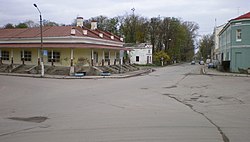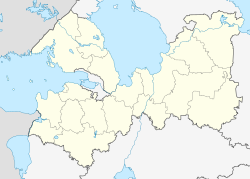Schlusselburg
| Shlisselburg (in English) Шлиссельбург (Russian) |
|
|---|---|
| - Town - | |
 A street in Shlisselburg |
|
 Location of Leningrad Oblast in Russia |
|
|
|
|
|
|
|
|
|
|
| Administrative status (as of June 2013) | |
| Country | Russia |
| Federal subject | Leningrad Oblast |
| Administrative district | Kirovsky District |
| Settlement municipal formation | Shlisselburgskoye Settlement Municipal Formation |
| Administrative center of | Shlisselburgskoye Settlement Municipal Formation |
| Municipal status (as of May 2010) | |
| Municipal district | Kirovsky Municipal District |
| Urban settlement | Shlisselburgskoye Urban Settlement |
| Administrative center of | Shlisselburgskoye Urban Settlement |
| Statistics | |
| Population (2010 Census) | 13,170 inhabitants |
| Time zone | MSK (UTC+03:00) |
| Founded | 1702 |
| Town status since | 1780 |
| Previous names | Petrokrepost (until 1992) |
| Postal code(s) | 187320 |
|
|
|
| on | |
Shlisselburg (Russian: Шлиссельбург; IPA: [ʂlʲɪsʲɪlʲˈburk]; German: Schlüsselburg; Swedish: Nöteborg) is a town in Kirovsky District of Leningrad Oblast, Russia, located at the head of the Neva River on Lake Ladoga, 35 kilometers (22 mi) east of St. Petersburg. From 1944 to 1992, it was known as Petrokrepost (Петрокрепость). Population: 13,170 (2010 Census);12,401 (2002 Census);12,589 (1989 Census).
The fortress and the town center are UNESCO World Heritage Sites.
A wooden fortress named Oreshek (Орешек) or Orekhov (Орехов) was built by Grand Prince Yury of Moscow (in his capacity as Prince of Novgorod) on behalf of the Novgorod Republic in 1323. It guarded the northern approaches to Novgorod and access to the Baltic Sea. The fortress is situated on Orekhovets Island whose name refers to nuts in Swedish as well as in Finnish (Pähkinäsaari, "Nut Island") and Russian languages.
...
Wikipedia



